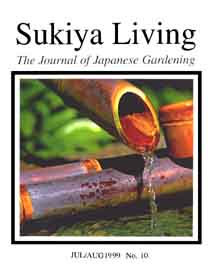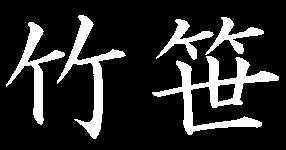|
Japanese Garden Journal
Bamboo
 Bamboo
is a stunningly useful plant/material. From bamboo plants in the
garden to bamboo blinds and bamboo flooring in the home, this "giant grass"
is one of the world's miracle materials.
Bamboo
is a stunningly useful plant/material. From bamboo plants in the
garden to bamboo blinds and bamboo flooring in the home, this "giant grass"
is one of the world's miracle materials.
Nowhere is the bamboo plant's versatility more apparent than in the Sukiya Living Environment. Think about it: living bamboo plants are a mainstay accent in Japanese landscapes. Bamboo poles are essential components in bamboo fencing. Bamboo timbers are used in teahouse construction and residential carpentry. And a seemingly endless list of bamboo products - from baskets to bamboo furniture - play a role in Japanese interior design.
The Japanese Garden Journal publishes regular articles about growing bamboo plants and about how bamboo materials are used in Japanese culture. These articles generally fall into at least one of the following categories:
--------------------------------------------------------------------------
BAMBOO PLANTS These articles are about growing bamboo, caring for bamboo plants, and using living bamboo in Japanese gardens. Bamboo is essentially a very large grass. Most Western gardeners are accustomed to using woody and herbaceous plant material. For them, bamboos are something entirely different, with unique and sometimes very confusing, cultivation techniques. These articles deal with black bamboo, moso bamboo, and many other bamboo varieties.
BAMBOO FENCING The bamboo fence is an important element in Japanese gardens. Bamboo fences, together with walls and hedges, provide much of the enclosure that make Japanese gardens feel so special and separate from the regular stressed out world. These JOJG articles discuss topics such as bamboo fence construction and the importance of garden enclosure.
BAMBOO TIMBERS Dried bamboo timbers have always been a traditional building material in Japan. Nowadays bamboo building materials are primarily used in decorative rather than structural roles. Beautiful bamboo can be seen in the tokonoma alcoves and decorative ceilings of Japanese tea houses and refined sukiya-style residences.
BAMBOO FLOORING For centuries wood and bamboo cane have been used for the floors of certain transition points in Japanese teahouses and sukiya-style residences. Nowadays a new type of "hardwood" bamboo flooring is being manufactured and installed in modern homes. These JOJG articles discuss both the traditional and modern versions of bamboo floors.
BAMBOO CRAFTS Bamboo is used in wide variety of Japanese crafts and bamboo home accessories. It is used in the manufacture of tea ceremony goods. It is a key ingredient in the art of Japanese basket making. And it is even used to some degree in the construction of Japanese furniture. These articles discuss various aspects of decorating with bamboo and using bamboo in the Sukiya Living environment.
LUCKY BAMBOO The subject of bamboo has its share of myths and misinformation. Some problems stem from the enormous popularity of the so-called "lucky bamboo" plants that are sold in ordinary flower shops all over the world. The truth is that lucky bamboo is NOT a real bamboo. These JOJG articles strive to correct the lucky bamboo myth and other types of bamboo misinformation.
------------------------------------------------------
